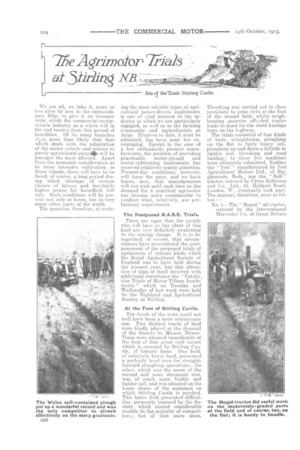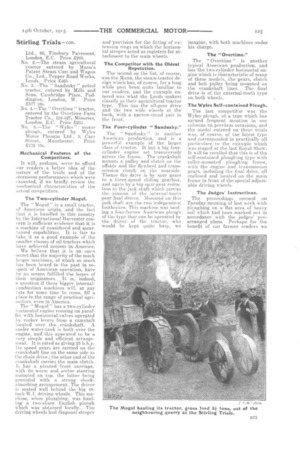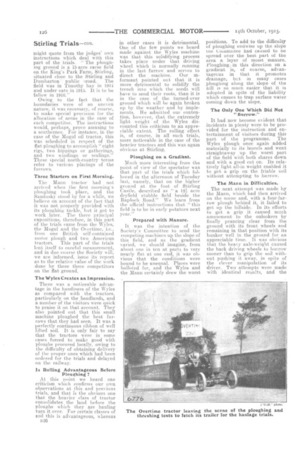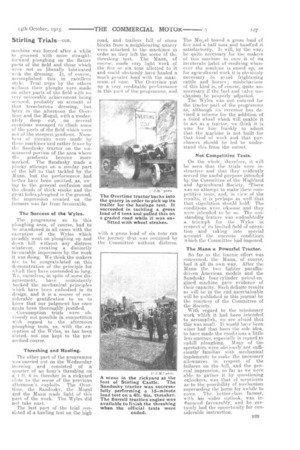7fie AgfrimatorTijah
Page 4

Page 5

Page 6

Page 7

If you've noticed an error in this article please click here to report it so we can fix it.
NB.1
Site of likeTriaL5 Stirling Castle
We are all, we take it, more or less alive by now to the extraordinary fillip, to give it no stronger term, which the 'commercial-motorvehicle industry as a whole will in the end receive horn this period of hostilities. Of its many branches more than likely that that -which deals with the adaptation of the motor vehicle and tractor to purely agricultural puff will be amongst the most affected. Apart from the economic consideration as to more -.intensive 'cultivation in these islands, there will have to be faced, of course, a long period during which shortage of certain classes of labour and inevitably higher prices for horseflesh will rule. Such conditions will be present not only at home, but in very many other narts of the world.
The question, therefore, of evo1v ing the most suitable types of agricultural power-driven implements is one of vital interest to the industry in which we are particularly engaged, as well as to the farming community and agriculturists at large. Progress to date, it must be
admitted, has been in too encouraging. Except n the case of a few enthusiastic pioneer manufacturers, the problem of providing practicable motor-plough and motor-cultivating implements has received relatively scanty attention. Present-day conditions, however, will force the pace, and we have hopes, now, that manufacturers will not wait until such time as the demand for a practical agrimotor has become more considerable to conduct what., relatively, are preliminary experiments.
The Postponed R.A.S.E. Trials.
There are signs that the people who will have to buy plant of this kind are very definitely awakening to the coming change. It is to be regretted, of course, that circumstances have necessitated the postponement of the proposed trials of ag-rimotors of various kinds which the Royal Agricultural Society of England was to have held during the present year, but this alteration of plan of itself invested with additional importance the " Exhibition Trials of Motor Tillage Implej ments " which on Tuesday and Wednesday of last week were held by the Hig-hland and Agricultural Society at Stirling.
At the Foot of Stirling Castle.
The loefile of the tests could not well have been a more picturesque one. Two distinct tracts of land were kindly placed at the disposal of the Society by Messrs. Dewar. These were situated immediately at the foot, of that great rock mount which is crowned by Stirling Castle, :if historic fame. One field, of relatively heavy land, presented a perfectly level area for straightforward ploughing operations ; the other, which was the scene of the second and more strenuous test, was of much more friable and lighter soil, and was situated on the lower slopes of the eminence on which Stirling Castle is perched. This latter field presented difficulties, purposely imposed by the Society, which caused considerable trouble to the. majority of competitors; but of that more anon.
Threshing was carried out in close proximity to some ricks at the foot of the second field, whilst neighbouring quarries afforded trailer loads to hand for the short haulage tests on the highway. The trials consisted of four kinds of tests, straightaway ploughing on the flat in fairly heavy soil, ploughing up and down a hillside in lighter soil, threshing and road hauling ; to these five machines were ultimately submitted. Neither the " Ivel," manufactured by Ivel Agricultural Motors •Ltd., of Biggleswade, Beds., nor the " Bull" tractor, entered by Cyrus Robinson and Co., Ltd., 61, Holland Road, London, W., eventually took part. The starters, therefore, were as follow :— No. I.—The "Mogul" oil tractor, entered by the International Harvester Co. of Great Britain Ltd., 80, Finsbury Pavement, London, E.C. Price £265.
No. 2.—The steam agricultural tractor entered by Mann's Patent Steam Cart and Wagon Co., Ltd., Pepper Road Works, Leeds. Price £465.
No. 3.---The " Sandusky " petrol tractor, entered by Mills and Sons, Cambridge Place, Paddington, London, W. Price 2577 10s.
No. 4.—The " Overtime " tractor, entered by the Overtime Farm Tractor Co., 124-127, Minories, London, E.C. Price No. 6.—The " Wyles " motor plough, entered by Wyles Motor Ploughs Ltd., 5, Carr Street, Manchester. Price £172 Thls.
Mechanical Features of the Competitors.
It will, perhaps, serve to afford our readers a better idea of the nature of the trials and of the strenuous performances which were expected, if we briefly review the mechanical characteristics of the actual competitors.
The Two-cylinder mogul.
The " Mogul " is a small tractor, of American origin, and the fact that it is handled in this country by the International Harvester concern is sufficient evidence that it is a machine of considered and ascertained capabilities. It is fair to take it as a good example of the smaller classes of oil tractors which have achieved success in America.
We believe that it is an open secret that the majority of the much larger machines, of which so much has been heard in the past in respect of American operation, have by no means fulfilled the hopes of their originators. It. is, indeed, a question if these bigger internalcombustion machines will, at any rate for some time to come, fill a place in the range of practical agrimotors, even in America.
The " Mogul " has a two-cylinder horizontal engine running on paraffin, with horizontal valves operated by rocker levers fro-in a camshaft located over the crankshaft. A cooler water-tank is built over the engine, and this appeared to be a very simple and efficient arrangement. It is rated as giving 25 b.h.p. its speed gears are carried on the crankshaft line on the same side as the chain drive ; the other end of the crankshaft carries the main clutch. lb has a pivoted front carriage, with its worm and sector steering mounted on top, the latter being provided with a strong shockabsorbing arrangement. The driver is seated well behind the big 45inch W.I. driving wheels. This machine, when ploughing. was hauling a two-share English plough which was obtained locally. The driving wheels had diagonal stropes
and provision for, the fitting of extension rings on which the horizontal stropes acted as registers for attachment to the main wheels.
The Competitor with the Oldest Reputation.
The second on the list, of course, was the Mann, the steam-tractor de_ sign which has, of course, for a long while past been quite familiar to our readers, and the example entered was what the Leeds makers classify as their agricultural-tractor type. This has the all-gear drive and the two wide wheels at the back, with a narrow-tread pair in the front.
The Four-cylinder "Sandusky."
The " Sandusky" is another American production, and is a powerful example of the larger class of tractor. It has a big fourcylinder engine set transversely across the frame. The crankshaft mounts a pulley and clutch on the offside and the flywheel and transmission clutch on the nearside. Thence the drive is by spur gears to a three-speed sliding gearbox, and again by a big spur-gear reduction to the jack shaft which carries the pinions of the internal-tooth gear final drives. Mounted on this jack shaft are the two independent .footbrakes. This machine was hauling a four-furrow American plough of the type that can be operated by the driver of the tractor, who would be kept quite busy, we
imagine, with both machines under his charge.
The "Overtime."
The " Overtime " is another typical American production, and has the two-cylinder horizontal engine which is characteristic of many of these models, the gears, clutch]. and belt, pulley being mounted on the crankshaft lines. The final drive is of the external-tooth type on both wheels. .
The Wyles Self-contained Plough.
The last competitor was the Wyles plough, of a type which has earned frequent mention in our columns on previous occasions, and the model entered on these trials was, of course, of the latest type and corresponded in practically all particulars to the ex'amp'le which was staged at the last Royal Show. It will he recalled that this is of the self-contained ploughing type with roller-mounted ploughing frame, with the engine and transmission gears, including the final drive, all enclosed and located on the main frame in front of the special adjustable driving wheels.
The Judges' Instructions.
The proceedings opened on Tuesday morning of last week with ploughing on a flat area of heavy soil which had been marked out in accordance with the judges' prearranged plans. Perhaps for the benefit of cur farmer readers we might quote from the judges' own instructions which deal with this part of the trials. " The ploughing ground is a 15-acre carse field on the King's Park Farm, Stirling, situated close to the Stirling and
Dumbarton" public 'road. The field was in Timothy bay in 1914 and under oats in 1915. It is to be fallow in 1916,"
Owing to the fact that the boundaries were of an uneven nature, it was necessary, of course, to make special provision for the allocation of areas in the case of each competitor. The instructions would, perhaps, prove amusing to a southerner. For instance, in the case of the Mogul oil tractor, this was scheduled in respect of the flat ploughing to accomplish " eight. rigs, two hippings or gatherings, and two windings or sealings." These special north-country terms refer to various placings of the furrows.
Three Starters on First Morning.
The Mann tractor had not arrived when the first morning's ploughing took place, and the Sandusky stood by for a while, we believe on account. of the -fact that it was not properly provided with its ploughingtackle, but it got to work later. The three principal expositions, therefore, in this part of the trials came from the Wyles, the Mogul and the Overtime, i.e., from one British self-contained motor plough and two American
tractors. This part of the trials lent itself to careful measurement, and in due course the Society will, we are informed, issue its report as to the relative value of the work done by these three competitors on the flat ground.
The Wyles Creates an Impression.
There was a noticeable advantage in the handiness of the Wyles as compared with the tractors, particularly on the headlands, and a number of the visitors were quick to praise it on that account. They also pointed out that this small machine ploughed the best furrows that they had seen. It was a perfectly continuous ribbon of well lifted soil. It is only fair to say that the tractors were in some eases forced to make good with ploughs procured locally, owing to the difficulty of obtaining delivery of the proper ones which had been ordered for the trials and delayed on the railway.
Is Rolling Advantageous Before Ploughing ?
At this point, we heard one eiitieism which confirms our own observations at this and previous trials, and that is the obvious one that the heavier class of tractor consolidates the land before the ploughs which they are hauling turn it over. For certain classes of soil this is advantageous, whereas 1-.26
in other eases it is detrimental. One of the few points we heard made against the Wyles machine was that this solidifying process takes place under that driving wheel which is normally running in the last furrow and serves to direct the machine.Our informant pointed out that it is more detrimental to solidify the trench into which the seeds will have to send their roots, than it is in the case of the turned-over ground which will be again broken up by the weather and by implements. He admitted our contention, however, that the extremely light weight of the, Wyles discounted this .criticism to an appreciable extent. The rolling effect is, of course. in all such trials, more noticeable in the case of the heavier tractors and this was again
• obvious at Stirling. • 'Ploughing on a Gradint.
Mach more interesting from the point of view of the spectator was that part of the trials which followed in the afternoon of Tuesday last, namely, that on the higher ground at the foot of Stirling
Castle, described as " 12 acre dryfield stubble field beside the Raploch Road." We learn from the official instructions that " this field is to be in early potatoes next year:'
Prepared with Manure.
It was the intention of the Society's Committee to send the competing machines up the slope of this field, and as the gradient varied, we should imagine, from about one in ten at parts to very nearly flat at one end, it was obvious that the conditions were bound to he unequal. Places were balloted for, and the Wyles and the Mann certainly drew the worst positions. To add to the difficulty of ploughing endwise up the slope Inc Liommucee had caused to be spread over the best part of the area a layer of moist manure. Ploughing, in this direction on a gradient is, of course, advantagecus in that it promotes drainage, but in many cases ploughing along the slope of the hill is so Mlleil easier that it is adopted in spite of the liability which ensues to trap surface water coming down the slope.
The Only One Which Did Not "Burrow."
It had now become evident that incidents in plenty were to be provided for the instruction and entertainment of visitors during this part of the programme. The Wyles plough once again added materially to its laurels and went straightaway up the worst part of the field with both shares down and with a good cut on. Its relatively light all-in weight enabled it to get a, grip on the friable soil without attempting to barrow.
The Mann in Difficulties.
The next attempt was made by the Mann, which had then arrived on the scene and, with a four-furrow plough behind it, it failed to get up the hillside. In its efforts to get a grip it caused much amusement to the onlookers by finally prancing clear from the ground with its front wheels and remaining in that position with its bunker. well in the ground for an appreciable time. It was obvious that the heavy axle-weight caused the back driving wheels to burrow sooner than to grip the soil without pushing. it away, in spite of the clever manipulation of its driver. Two attempts were made with identical results, and the machine was forced after a while to proceed with more straightforward ploughing on the flatter parts of the held and those which were not ,so liberally lubricated with the dressing. It, of course, accomplished this in excellent style. Trial trips by the others without their ploughs were made on other parts of the field with no very noticeable achievement being secured, probably on account of that treacherous dressing, but later in the afternoon the Overtime and the Mogul, with a moderately. deep cut, on several occasions managed to climb some of the parts of the field which were not of the steepest gradient. Numbers of circuits were made by these machines and rather fewer by the Sandusky tractor on the 1111m allured portion of the area where the gradients become more marked. The Sandusky made a plucky attempt on a similar part of the hill to that tackled by the Mann, but the performance had better have been omitted, as, owing to the general confusion and the clouds of thick smoke and the great holes ploughed in the ground, the impression created on the farmers was far from favourable.
The Success of the Wyles.
The programme as to this ploughing area, of course, had to be abandoned in all cases with the exception of the. Wyles which steadily went on ploughing up and down hill without any distress whatever, creating a distinctly favourable impression by the work it was doing. We think the makers are to be congratulated on this demonstration of the principle for which they have contended so long. We, ourselves, in spite of some disagreement, have consistently backed the mechanical principles which have been embodied in its design, and it is a source of considerable gratification to us to know that our judgment has once again been thoroughly justified.
Consumption trials were obviously not possible in competition with regard to the afternoon ploughing tests, as, with the exception of the Wyles, as has been stated, not one kept to the prescribed course.
Threshing and Hauling.
• The other part of the programme was carried out on the Wednesday morning and consisted of a quarter of an, hour's threshing on a 4 ft. 6 in. thresher in a rickyard .close to the scene of the previous afternoon's exploits. The Overtime, the Sandusky, the Mogul and the Mann made light of this part of the work. The Wyles did not take Part.
The last part of the trial consisted of a hauling test on the high road, and trailers full of stone blocks from a.neighbouring _quarry were attached to the machines in order as they left the scene of the threshing test, The Mann, of course, made very light work of the five or six tons allotted to it and could obviously have hauled a much greater load with the maximum of ease. The Overtime put up a very creditable performance in this part of the programme, and with a gross load of six tons ran the journey that was required by the Committee without distress.
The Morel towed a gross load of five and a half tons and handled it satisfactOrily. It will, by the way, be quite necessary for the makers of this machine to cure it of ita inveterate habit of misfiring whenever the machine is eased up, as for agricultural work it is obviously necessary to avoid frightening cattle and horses ; misbehaviour of this kind is, of course, quite unnecessary if the fuel and valve mechanism be properly adjusted.
The Wyles was not entered for the tractor part of the programme as, although its inventor has devised a scheme for the addition of a third wheel which will enable it to act as a tractor, we think it is wise for him frankly to admit that the machine is not built for that kind of work and that purchasers should be led to understand this from the outset.
Not Competitive Tests.
On the whole, -therefore, it will be seen that the trials were instructive and that they evidently served the useful purpose intended by the Committee of the Highland and Agricultural Society. 'There was no attempt to make them competitive tests, and, in view of the results, it is perhaps as well that that stipulation should hold. The conditions were irksome and they were intended to be so. The outstanding feature was undoubtedly a triumph for the Wyles in respect of its limited field of operation and taking into special account the onerous conditions which the Committee had imposed.
The Mann a Powerful Tractor.
So far as the tractor effort was concerned, the Mann, of course, had it all its own way. After the Mann the two lighter paraffindriven American models and the Sandusky four-cylinder petrol-engmed machine gave evidence of their.capacity. Such definite results as will be in the end ascertainable will be published in this journal by the courtesy of the Committee of the Society. With regard to the missionary work which it had been intended to accomplish, we are afraid that this was small. It would have been wiser had that been the sole idea, to have made the conditions a little less-onerous, especially in regard to uphill ploughing. Many of the spectators were obviously not sufficiently familiar With mechanical implements to make the necessary allowances in respect of the failures on the hill, and the general' impression, so far as we. were able to gather it by questioning onlookers, was that of scepticism as to the possibility of mechanism superseding the horse for awhile to come. The better-class farmer, with --Ws wider outlook, was influenced favourably, and he certainly had the opnortunity for considerable instruction.




















